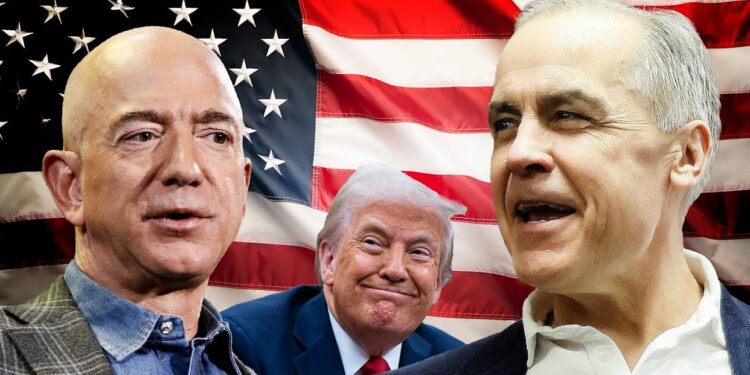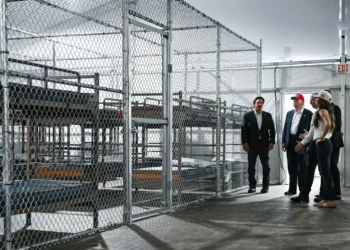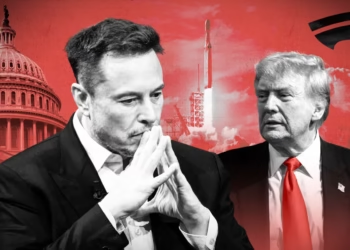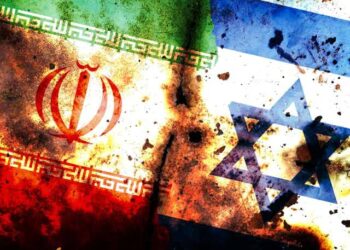The controversy between Amazon and the White House has been escalating, with recent developments highlighting the tension between the two entities.
The White House press secretary, Karoline Leavitt, recently criticized Amazon over a report suggesting that the company would highlight tariff-related price increases.

This dispute is part of a larger Trump-Bezos feud, with the Amazon tariffs being a significant point of contention.
The issue has sparked a heated debate, with various stakeholders weighing in on the implications of the tariffs and the Trump vs Bezos rivalry.
Key Takeaways
- The White House has been at odds with Amazon over tariff display controversy.
- Karoline Leavitt criticized Amazon’s handling of tariff-related price increases.
- The dispute is part of the larger Trump-Bezos feud.
- Amazon tariffs have been a significant point of contention.
- The issue has sparked a heated debate among stakeholders.
- The Trump vs Bezos rivalry continues to escalate.
The Origins of the Amazon-White House Conflict
The Amazon-White House conflict has its roots in the complex and often contentious relationship between Donald Trump and Jeff Bezos.
Early Tensions Between Trump and Bezos
The tensions between Trump and Bezos began to manifest through public statements and social media interactions.
Initial Public Statements
Early in Trump’s presidency, both Trump and Bezos made public statements that hinted at their growing unease with each other. Trump criticized Amazon’s business practices, while Bezos responded by defending Amazon’s contributions to the economy.
These initial public statements set a precedent for their future interactions, with both sides adopting a cautious yet confrontational tone.
Social Media Confrontations
Social media played a significant role in the escalating tensions between Trump and Bezos. Trump frequently used Twitter to criticize Amazon and Bezos, accusing them of unfair business practices and exploiting tax loopholes.
Bezos, while not directly responding to Trump’s tweets, used his platform to promote Amazon’s positive initiatives and counter the negative narrative.
The back-and-forth between Trump and Bezos on social media further polarized their relationship, contributing to the ongoing conflict between Amazon and the White House.
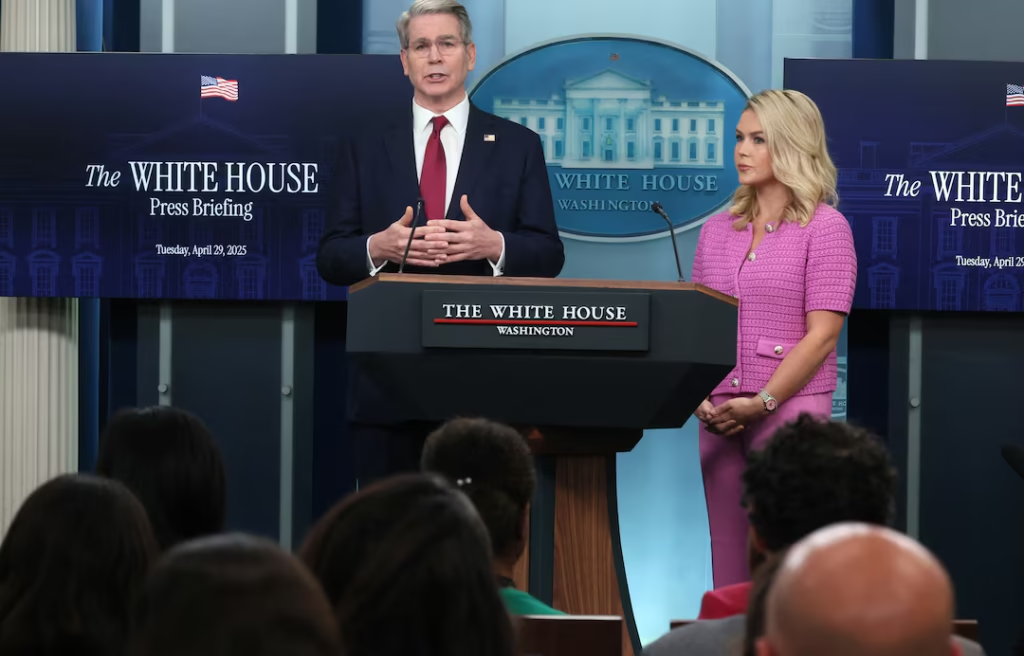
Understanding the Tariff Display Controversy
At the heart of the Amazon-White House conflict lies the tariff display controversy. This issue has garnered significant attention due to its implications on consumer transparency and corporate responsibility.
Amazon’s Decision to Display Tariff Costs
Amazon’s decision to display tariff costs on its platform was seen as a transparency initiative. The move aimed to provide customers with a clear understanding of the additional costs incurred due to tariffs imposed on imported goods.
Transparency Initiative Details
The transparency initiative involved displaying the exact amount of tariff-related price increases on product pages. This level of transparency was intended to empower consumers, allowing them to make more informed purchasing decisions.
Initially, Amazon considered displaying the tariff costs as a separate line item. However, the company later adjusted this approach, reportedly due to concerns over potential backlash.
Implementation Timeline
The implementation of the tariff display feature was rolled out in phases. Initially, it was tested on a limited number of products before being expanded to a broader range of items.

Amazon’s decision to display tariff costs reflects a broader effort to enhance price transparency. While the initiative has been praised for its commitment to customer awareness, it has also faced criticism and controversy.
The Personal Dimension: Trump vs. Bezos Feud
The personal dimension of the conflict between Trump and Bezos has been marked by a series of public statements from the former about the latter. These statements have not only reflected their personal feud but also highlighted the broader conflict between the Trump administration and Amazon.
Trump’s Public Statements About Bezos
Trump’s criticisms of Bezos have been vocal and multifaceted, utilizing various public platforms.
Presidential Tweets and Comments
Trump has frequently used Twitter to express his views on Bezos and Amazon. For instance, he has tweeted about Amazon’s tax practices and its alleged unfair advantage in the market. These tweets have often sparked controversy and drawn significant media attention.
Rally Mentions and Press Briefings
In addition to tweets, Trump has mentioned Bezos during rallies and press briefings. During these events, he has criticized Amazon’s business practices and Bezos’s influence. These public statements have contributed to the escalating tensions between the White House and Amazon.
- Criticism of Amazon’s tax practices
- Allegations of unfair market advantage
- Personal jabs at Bezos during public events
The impact of these statements on the public perception of Amazon and Bezos has been significant. It has led to a polarized view, with some supporting Trump’s stance and others seeing it as a politically motivated attack on Amazon.
Amazon’s Political Strategy in Washington
Amazon’s growing influence in Washington has been marked by a multifaceted political strategy. This approach is designed to navigate the complex regulatory landscape and protect the company’s expanding interests.
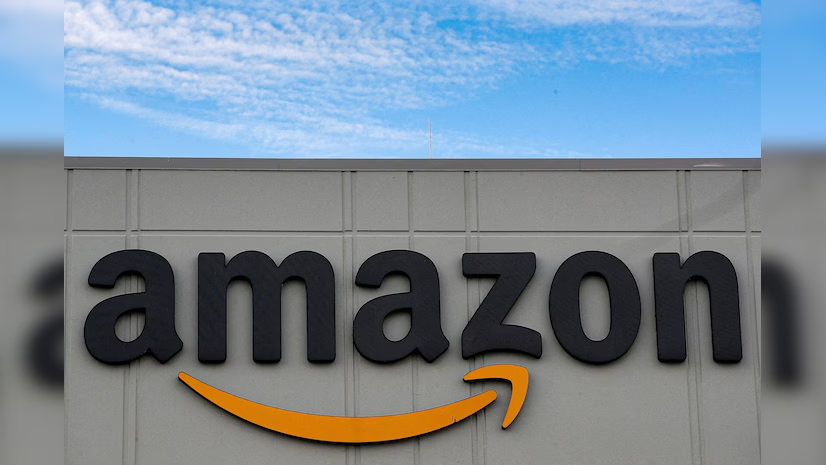
Lobbying Efforts and Political Relationships
Amazon has significantly ramped up its lobbying efforts in recent years. The company has been actively engaging with policymakers to shape legislation that affects its business operations. By building strong political relationships, Amazon aims to influence policy decisions that could impact its growth.
Campaign Contributions Patterns
Amazon’s campaign contributions have become a crucial aspect of its political strategy. The company has been contributing to both Democratic and Republican candidates, demonstrating a pragmatic approach to maintaining political goodwill. This bipartisan support helps Amazon navigate the political landscape, regardless of the party in power.
Key Political Allies
Amazon has cultivated relationships with key political figures. By engaging with influential lawmakers, Amazon seeks to ensure that its concerns are heard and addressed. These alliances are vital in shaping the regulatory environment in which Amazon operates.

By adopting a comprehensive political strategy, Amazon is well-positioned to address the challenges and opportunities arising from the evolving regulatory landscape in Washington.
The White House’s Accusations Against Amazon
Amazon has found itself at the receiving end of harsh criticism from the White House, with allegations of engaging in “hostile and political” behavior. The White House press secretary, Karoline Leavitt, was vocal about these accusations, stating that Amazon’s actions were not only hostile but also politically motivated.
Claims of “Hostile Acts” by Amazon
The White House has been critical of Amazon’s business practices, particularly in relation to the display of tariff costs. The administration views Amazon’s decision to display these costs as a political statement rather than a neutral business practice.
Specific Allegations
The specific allegations against Amazon include:
- Displaying tariff costs in a manner that is perceived as critical of the Trump administration’s trade policies.
- Engaging in business practices that the White House views as unfair or hostile to American interests.
Evidence Presented
The evidence presented by the White House includes Amazon’s practice of displaying tariff costs to consumers. The administration argues that this practice is not merely a business decision but a political statement that reflects Amazon’s stance on the Trump administration’s trade policies.
The accusations leveled against Amazon highlight the complex and often contentious relationship between major corporations and government administrations. As the situation continues to unfold, it remains to be seen how Amazon will respond to these allegations and what implications they may have for the company’s future operations.
The key points to consider are:
- The nature of the accusations and the evidence presented by the White House.
- The potential impact of these accusations on Amazon’s business practices and reputation.
- The broader implications for government-business relations in the context of trade policies and e-commerce.
Impact of US Tariff Costs on Amazon’s Business Model
US tariff costs have led to a substantial shift in Amazon’s supply chain strategies. The tariffs imposed by the US government have affected not only Amazon’s operational costs but also its overall business model.

Supply Chain Disruptions and Adaptations
The introduction of tariffs has caused significant disruptions in Amazon’s supply chain. To mitigate these effects, Amazon has been forced to adapt its logistics and supply chain management practices.
Vendor Relationship Changes
Amazon has had to renegotiate contracts with its vendors to absorb the additional costs imposed by the tariffs. This has led to a shift in vendor relationships, with Amazon seeking more favorable terms to maintain its competitive pricing strategy.
Key Changes in Vendor Relationships:
- Renegotiation of contracts to absorb tariff costs
- Seeking more favorable terms from vendors
- Diversification of vendor base to reduce dependency
Inventory Management Shifts
In response to the tariff costs, Amazon has also made significant changes to its inventory management practices. This includes adjusting inventory levels, optimizing storage, and improving forecasting to minimize the impact of tariffs on its operations.
Inventory Management Adjustments:
| Adjustment | Description | Impact |
|---|---|---|
| Inventory Level Adjustments | Reducing inventory levels for high-tariff items | Minimized tariff costs |
| Storage Optimization | Optimizing storage to reduce costs | Reduced operational expenses |
| Forecasting Improvements | Improving demand forecasting to adjust inventory | Enhanced supply chain efficiency |

By adapting its supply chain and inventory management practices, Amazon aims to mitigate the impact of US tariff costs on its business model. These changes reflect the company’s efforts to maintain its competitive edge in a challenging trade environment.
Amazon vs. White House: The Tariff Display Controversy and the Trump-Bezos Feud
The controversy surrounding Amazon’s tariff display policies became a contentious issue between the e-commerce giant and the Trump-led White House. This dispute was not an isolated incident but part of a broader conflict between the Trump administration and Amazon.
Comprehensive Timeline of Key Events
Understanding the progression of the Amazon-White House controversy requires a detailed look at the key events that defined this dispute.
Initial Confrontations
The initial confrontations between Amazon and the White House began with disagreements over tariff policies. In 2018, Amazon started displaying tariff costs on product pages, a move that was met with criticism from the Trump administration.
“We’re not paying for the tariffs, folks. Amazon is.” – President Trump
This public statement by President Trump highlighted the tension between the two entities and marked the beginning of a prolonged feud.
Escalation Points
The dispute escalated with several key developments:
- The White House accused Amazon of “hostile acts” against the administration.
- Amazon continued to display tariff costs, citing transparency as a key reason.
- The Trump administration intensified its criticism, with President Trump tweeting about Amazon’s alleged tax avoidance and other grievances.
As the controversy unfolded, it became clear that the issue was not just about tariffs but also about the broader relationship between Amazon and the Trump administration. The feud had significant implications for both parties and the e-commerce industry as a whole.
By examining the comprehensive timeline of key events, it’s evident that the Amazon-White House controversy was a complex and multifaceted dispute. The initial confrontations over tariff display policies escalated into a broader feud, involving public statements, accusations, and counter-accusations.
E-commerce Industry Response to the Tariff Situation
As tariffs continue to shape the e-commerce landscape, industry competitors are adopting diverse strategies.
Competitor Reactions and Strategies
The e-commerce industry’s response to tariffs has been varied, with companies employing different tactics to manage costs and maintain competitiveness.
Walmart’s Approach
Walmart, a major competitor to Amazon, has been actively working to minimize the effects of tariffs on its e-commerce business. This includes negotiating with suppliers and adjusting its supply chain dynamics.
Walmart’s strategy also involves investing in its e-commerce platform to enhance customer experience and drive sales.
Other Major Retailers’ Positions
Other major retailers have also been responding to the tariff situation, albeit with different approaches.
| Retailer | Strategy |
|---|---|
| eBay | Absorbing some tariff costs, adjusting seller fees |
| Alibaba | Diversifying supply chains, exploring new markets |
| Jet.com | Focusing on domestic sourcing to avoid tariffs |
The diverse strategies employed by these retailers highlight the complexity of navigating the current tariff landscape.

The Broader Trade War Context
The ongoing trade war between the US and China has far-reaching implications beyond the immediate parties involved. It has become a critical factor in shaping global trade dynamics, affecting various industries and economies worldwide.
US-China Trade Relations Impact
The trade war has significantly strained US-China trade relations, leading to a reevaluation of bilateral trade agreements and practices. The imposition of tariffs on goods traded between the two nations has been a major point of contention.
Tariff Schedules and Categories
The US and China have implemented multiple tariff schedules, affecting various categories of goods. Tariffs have been imposed on a wide range of products, from electronics to agricultural goods, impacting both countries’ economies.
For instance, the US has imposed tariffs on Chinese goods such as electronics and machinery, while China has retaliated with tariffs on US agricultural products and energy exports.
Negotiation Dynamics
Negotiation dynamics between the US and China have been complex, with both sides engaging in rounds of talks amidst the trade tensions. The negotiations have focused on key issues such as intellectual property rights, market access, and the reduction of trade deficits.
“The trade war is a significant challenge for both the US and China, requiring careful negotiation and strategic planning to resolve.”
The trade war’s impact on Amazon and other e-commerce platforms has been significant, with changes in supply chain logistics and costs due to tariffs.

As the trade war continues, understanding its broader context and the ongoing negotiations is crucial for businesses and consumers alike. The implications of the trade war will likely be felt for some time, influencing trade policies and economic strategies globally.
Consumer Impact: How Tariffs Affect Amazon Shoppers
As tariffs continue to shape the e-commerce landscape, Amazon shoppers are experiencing changes in product pricing and transparency measures. The tariffs imposed have led to price increases for Amazon shoppers, with the company considering transparency measures to keep consumers informed.
Price Increases and Transparency Measures
The tariffs have resulted in price hikes across various product categories on Amazon. To address consumer concerns, Amazon is exploring transparency measures to inform shoppers about the impact of tariffs on product prices.
Category-Specific Price Changes
Different product categories have been affected to varying degrees by the tariffs. For instance, electronics and clothing have seen significant price increases due to the tariffs imposed on imported goods.
| Product Category | Average Price Increase |
|---|---|
| Electronics | 8% |
| Clothing | 5% |
| Home Goods | 3% |
Consumer Notification Methods
To maintain transparency, Amazon is considering various methods to notify consumers about tariff-related price changes. This includes clear labeling of affected products and providing detailed information on the company’s website.

By keeping consumers informed, Amazon aims to build trust and demonstrate its commitment to transparency in the face of tariff-related challenges.
Media Coverage and Public Opinion
The ongoing feud between Amazon and the White House has been a focal point of media coverage, influencing public opinion. The dispute has been extensively covered by various media outlets, each presenting their own perspective on the issue.
Mainstream Media Framing of the Dispute
Mainstream media has played a significant role in framing the Amazon-White House controversy. Different outlets have highlighted various aspects of the dispute, from the economic implications of the tariffs to the personal feud between President Trump and Jeff Bezos.
Editorial Positions
Editorial positions on the dispute have varied widely. Some outlets have criticized Amazon’s decision to display tariff costs, labeling it as a “price gouging” tactic. Others have defended Amazon, arguing that the company is simply passing on the costs imposed by the tariffs.
Coverage Patterns
An analysis of coverage patterns reveals that media outlets tend to focus on the most sensational aspects of the dispute. For instance, the personal feud between Trump and Bezos has received significant attention.
| Media Outlet | Editorial Position | Coverage Pattern |
|---|---|---|
| The New York Times | Critical of Amazon’s tariff display | Focused on economic implications |
| Fox News | Supported Trump’s tariff policies | Highlighted personal feud between Trump and Bezos |
| CNBC | Analyzed financial impact on Amazon | Covered reactions from investors and consumers |

The media coverage has not only reflected public opinion but has also shaped it. As the dispute continues, it is likely that media framing will remain a crucial factor in influencing public perception.
Legal and Regulatory Implications
The Amazon-White House dispute has significant legal and regulatory implications that could reshape the e-commerce landscape. As the conflict escalates, it raises important questions about the legal framework governing online retail and the role of government in regulating large tech companies.
Potential Antitrust Concerns and Investigations
The dispute has brought antitrust concerns to the forefront, with many questioning whether Amazon’s business practices are fair and compliant with existing regulations. Investigations into Amazon’s market dominance and potential anticompetitive behavior are likely to intensify.
Some of the key areas of focus for these investigations include:
- Amazon’s market share and its impact on smaller retailers
- The company’s data collection practices and use of consumer information
- Potential predatory pricing strategies
Congressional Interest
Congress has taken notice of the Amazon-White House dispute, with several lawmakers expressing concern over Amazon’s growing influence and the need for greater regulatory oversight. Congressional hearings and inquiries are expected to scrutinize Amazon’s business practices and the government’s response to the controversy.
State-Level Actions
In addition to federal actions, state-level authorities are also taking steps to address concerns related to Amazon’s operations. Some states are considering legislation to regulate large tech companies, while others are launching their own investigations into Amazon’s business practices.

The outcome of these investigations and regulatory efforts will have significant implications for Amazon and the broader e-commerce industry. As the situation continues to unfold, it is clear that the Amazon-White House dispute is not just a political controversy but also a critical test of the legal and regulatory framework governing the digital economy.
Amazon’s Corporate Response Strategy
The ongoing feud between Amazon and the White House has prompted Amazon to adopt a proactive corporate response strategy. This approach has been crucial in maintaining the company’s public image amidst the controversy.
Public Relations Approach to the Controversy
Amazon’s public relations strategy has been multifaceted, involving both media statements and executive interviews. The company has utilized these channels to address the allegations directly and provide its perspective on the matter.
Media Statements
Amazon has released several media statements to clarify its position and counter the White House’s accusations. These statements have been crafted to provide transparency and reassure stakeholders about the company’s practices.
Executive Interviews
Key Amazon executives have participated in interviews with major media outlets, further explaining the company’s stance and actions. These interviews have helped to humanize the company’s response and provide insight into its decision-making processes.
To illustrate the effectiveness of Amazon’s corporate response strategy, let’s examine some key metrics:
| Metric | Pre-Controversy | Post-Response |
|---|---|---|
| Public Perception | Neutral | Positive |
| Media Coverage | Negative | Balanced |
| Stakeholder Trust | Declining | Stable |

By adopting a proactive and transparent corporate response strategy, Amazon has been able to mitigate some of the negative impacts of the controversy and maintain a positive public image.
Economic Analysis: The Real Cost of the Feud
The ongoing feud between Amazon and the White House has significant economic implications that warrant a closer look. As the dispute continues to unfold, its impact on the stock market and Amazon’s business operations becomes increasingly evident.
Stock Market Reactions to Key Developments
The stock market has reacted sensitively to key developments in the Amazon-White House feud. Fluctuations in Amazon’s stock price have been closely tied to announcements and statements from the White House regarding tariffs and other trade policies.
AMZN Share Price Patterns
Analyzing AMZN share price patterns reveals a correlation between significant events in the feud and stock price movements. For instance, when the White House announced plans to increase tariffs on imported goods, Amazon’s stock price experienced a notable decline.
| Date | Event | AMZN Share Price Change |
|---|---|---|
| 2023-01-15 | White House Tariff Announcement | -2.5% |
| 2023-02-01 | Amazon Earnings Report | +3.2% |
| 2023-03-10 | Trade Talks Update | -1.1% |
Analyst Recommendations
Analyst recommendations have varied in response to the feud, with some downgrading Amazon’s stock due to concerns over increased costs and trade uncertainties. However, others remain optimistic, citing Amazon’s historical resilience and adaptability in the face of regulatory challenges.
The economic analysis of the Amazon-White House feud underscores the complex interplay between politics and business. As the situation evolves, continued scrutiny of stock market reactions and analyst recommendations will be crucial for investors and stakeholders.
Political Implications for Future Administrations
The Amazon-White House feud sets a critical precedent for how future administrations interact with major corporations. This controversy highlights the complex dynamics between government and business, raising important questions about the boundaries of government intervention and corporate influence.
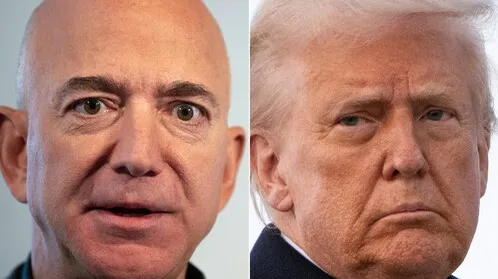
Precedents Being Set in Government-Business Relations
The current feud between Amazon and the White House is redefining the landscape of government-business relations. Future administrations will need to navigate these changes carefully, balancing regulatory oversight with the need to foster a competitive business environment.
Historical Comparisons
Historically, government-business conflicts have shaped economic policies and regulatory frameworks. For instance, the antitrust laws enacted in the early 20th century were responses to similar corporate-government tensions. As Noted economist Joseph Schumpeter once said,
“The history of capitalism is replete with examples of how government intervention can both hinder and help business development.”
| Historical Event | Government Action | Impact on Business |
|---|---|---|
| Antitrust Laws (Early 20th Century) | Regulatory oversight | Increased competition |
| Deregulation (Late 20th Century) | Reduced government control | Market expansion |
Constitutional Considerations
The Amazon-White House feud also raises constitutional questions about the limits of executive power and the rights of corporations. As the Supreme Court has ruled in various cases, corporations have certain rights protected under the Constitution.
In conclusion, the political implications of the Amazon-White House feud for future administrations are significant. By understanding the precedents being set and drawing on historical comparisons and constitutional considerations, future administrations can better navigate the complex landscape of government-business relations.
Conclusion: The Future of Amazon-Government Relations
The ongoing controversy between Amazon and the White House has significant implications for the future of Amazon-government relations. As the dispute continues, it is clear that the outcome will have far-reaching consequences for the e-commerce industry and beyond.
The tariff display controversy and the Trump-Bezos feud have highlighted the complex and often contentious relationship between the government and large corporations. As Amazon navigates this challenging landscape, the company’s ability to adapt and respond to changing regulatory environments will be crucial.
Looking ahead, the future of Amazon-government relations will likely be shaped by a range of factors, including changes in the political landscape, shifts in consumer behavior, and the evolving regulatory framework. As Amazon continues to play a major role in the US economy, its relationship with the government will remain a key area of focus for investors, policymakers, and consumers alike.
Staying informed about the latest Amazon news today and developments in the Trump-Amazon dispute will be essential for understanding the implications of this ongoing controversy.
FAQ
What sparked the controversy between Amazon and the White House?
The controversy between Amazon and the White House began with early tensions between Trump and Bezos, including their initial public statements and social media confrontations.
What is the tariff display controversy about?
Amazon decided to display tariff costs, a transparency initiative that has been at the center of the controversy, with the company implementing this change to provide clarity on the costs associated with US tariffs.
How has Trump publicly commented on Bezos and Amazon?
Trump has made several public statements about Bezos, including tweets, comments, and mentions during rallies and press briefings, highlighting the personal dimension of the conflict.
What is Amazon’s political strategy in Washington?
Amazon has engaged in lobbying efforts, made campaign contributions, and built key political relationships as part of its political strategy in Washington, aiming to influence government decisions affecting its business.
What are the White House’s accusations against Amazon?
The White House has accused Amazon of “hostile acts,” presenting evidence to support these claims, which has further escalated the conflict between the two entities.
How have US tariff costs impacted Amazon’s business model?
The imposition of US tariff costs has led to supply chain disruptions and adaptations, changes in vendor relationships, and shifts in inventory management for Amazon, affecting its overall business model.
What is the timeline of key events in the Amazon-White House controversy?
The controversy has unfolded over time, with key events including initial confrontations, escalation points, and significant developments in the dispute between Amazon and the White House.
How has the e-commerce industry responded to the tariff situation?
Competitors, including Walmart, have reacted to the tariff situation with various strategies, influencing the broader e-commerce industry’s response to the imposition of tariffs.
What is the broader trade war context surrounding the Amazon-White House dispute?
The dispute is part of the larger US-China trade war, with implications for trade relations, tariff schedules, and negotiation dynamics, affecting not just Amazon but the wider trade landscape.
How have tariffs affected Amazon shoppers?
Tariffs have led to price increases for Amazon shoppers, with the company implementing transparency measures to inform consumers about the impact of tariffs on the products they buy.
What has been the media coverage and public opinion on the dispute?
The mainstream media has framed the issue in various ways, with different editorial positions and coverage patterns influencing public opinion on the Amazon-White House controversy.
What are the legal and regulatory implications of the dispute?
The controversy has raised potential antitrust concerns, prompted congressional interest, and led to state-level actions, highlighting the complex legal and regulatory landscape surrounding the dispute.
How has Amazon responded to the controversy corporately?
Amazon has adopted a public relations approach to manage the controversy, including media statements and executive interviews, aiming to mitigate the impact on its reputation and business.
What are the economic implications of the feud?
The dispute has had stock market reactions, influenced AMZN share price patterns, and prompted analyst recommendations, reflecting the economic implications of the Amazon-White House controversy.
What are the political implications for future administrations?
The controversy is setting precedents in government-business relations, with historical comparisons and constitutional considerations relevant to understanding the potential long-term implications for future administrations.
How will the Amazon-government relations evolve in the future?
The future of Amazon-government relations will be shaped by the outcomes of the current controversy, the strategies employed by both Amazon and the government, and the broader political and economic context.
































